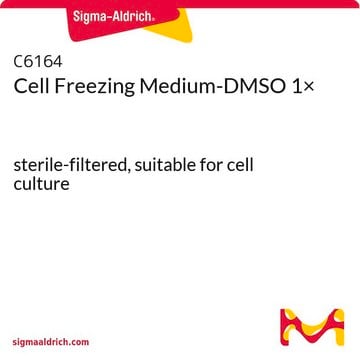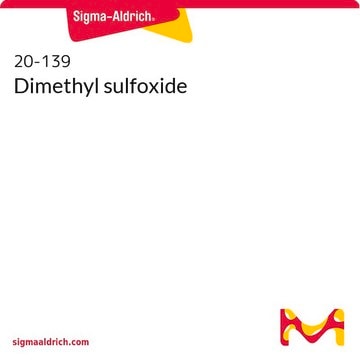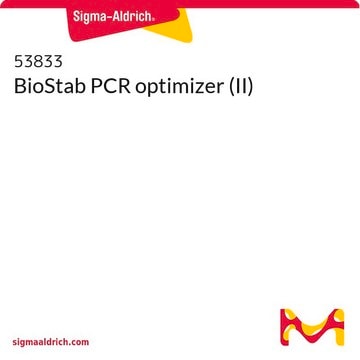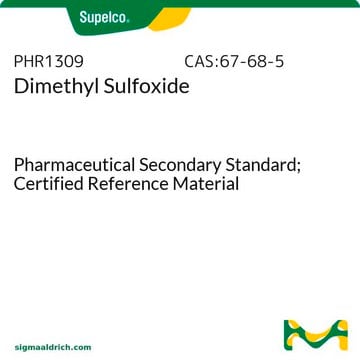If this product has an expiration or retest date, it will be shown on the Certificate of Analysis (COA, CofA). If there is no retest or expiration date listed on the product's COA, we do not have suitable stability data to determine a shelf life. For these products, the only date on the COA will be the release date; a retest, expiration, or use-by-date will not be displayed.
For all products, we recommend handling per defined conditions as printed in our product literature and website product descriptions. We recommend that products should be routinely inspected by customers to ensure they perform as expected.
For products without retest or expiration dates, our standard warranty of 1 year from the date of shipment is applicable.
For more information, please refer to the Product Dating Information document: https://www.sigmaaldrich.com/deepweb/assets/sigmaaldrich/marketing/global/documents/449/386/product-dating-information-mk.pdf
D9170
Diméthylsulfoxyde
PCR Reagent
Synonyme(s) :
DMSO, Sulfoxyde de méthyle
About This Item
Produits recommandés
Qualité
PCR Reagent
Densité de vapeur
2.7 (vs air)
Pression de vapeur
0.42 mmHg ( 20 °C)
Essai
≥99.5%
Forme
liquid
Température d'inflammation spontanée
573 °F
Durée de conservation
Recommended retest period - 2 years
Limite d'explosivité
42 %, 63 °F
Conditionnement
vial of 1 mL
Technique(s)
PCR: suitable
Impuretés
≤0.1% water
water
Couleur
colorless
Indice de réfraction
n20/D 1.479 (lit.)
pb
189 °C (lit.)
Pf
16-19 °C (lit.)
Solubilité
H2O: miscible (completely)
Densité
1.10 g/mL (lit.)
Adéquation
suitable for PCR
Application(s)
agriculture
Chaîne SMILES
CS(C)=O
InChI
1S/C2H6OS/c1-4(2)3/h1-2H3
Clé InChI
IAZDPXIOMUYVGZ-UHFFFAOYSA-N
Vous recherchez des produits similaires ? Visite Guide de comparaison des produits
Description générale
Application
Attention
Autres remarques
Dimethyl Sulfoxide Miscibility/Immiscibility Table
Code de la classe de stockage
10 - Combustible liquids
Classe de danger pour l'eau (WGK)
WGK 1
Point d'éclair (°F)
188.6 °F - closed cup
Point d'éclair (°C)
87 °C - closed cup
Équipement de protection individuelle
Eyeshields, Gloves, type ABEK (EN14387) respirator filter
Faites votre choix parmi les versions les plus récentes :
Déjà en possession de ce produit ?
Retrouvez la documentation relative aux produits que vous avez récemment achetés dans la Bibliothèque de documents.
Les clients ont également consulté
-
How can I determine the shelf life / expiration / retest date of this product?
1 answer-
Helpful?
-
-
How is shipping temperature determined? And how is it related to the product storage temperature?
1 answer-
Products may be shipped at a different temperature than the recommended long-term storage temperature. If the product quality is sensitive to short-term exposure to conditions other than the recommended long-term storage, it will be shipped on wet or dry-ice. If the product quality is NOT affected by short-term exposure to conditions other than the recommended long-term storage, it will be shipped at ambient temperature. As shipping routes are configured for minimum transit times, shipping at ambient temperature helps control shipping costs for our customers. For more information, please refer to the Storage and Transport Conditions document: https://www.sigmaaldrich.com/deepweb/assets/sigmaaldrich/marketing/global/documents/316/622/storage-transport-conditions-mk.pdf
Helpful?
-
-
What is the molarity of DMSO?
1 answer-
DMSO will have a molarity of 14.1M, based on a density of 1.1 g/mL and a molecular weight of 78.13 g/mol.
Helpful?
-
-
What is the DMSO dissolved in?
1 answer-
DMSO is not dissolved in any solvent. It is a pure chemical compound that is a liquid at room temperature.
Helpful?
-
-
Does DMSO have any synthetic utility?
1 answer-
DMSO has been used to oxidize thiols and disulfides to sulfonic acids, hydrolysis of epoxides, thioalkylation of phenols, and oxidation of primary alcohols and halides, and esters of primary alcohols to aldehydes.
Helpful?
-
-
Dimethyl sulfoxide (DMSO) should be a liquid. Why did it arrive as a solid?
1 answer-
DMSO supercools easily, and re-melts slowly at room temperature. The melting point is 16-19 °C. The solidified product can be re-liquefied by warming to room temperature without detriment to the product.
Helpful?
-
-
What is the Department of Transportation shipping information for this product?
1 answer-
Transportation information can be found in Section 14 of the product's (M)SDS.To access the shipping information for this material, use the link on the product detail page for the product.
Helpful?
-
-
Where does DMSO come from?
1 answer-
DMSO is known to have been isolated from tree bark in the past. It is now a commericially synthesized solvent.
Helpful?
-
Active Filters
Notre équipe de scientifiques dispose d'une expérience dans tous les secteurs de la recherche, notamment en sciences de la vie, science des matériaux, synthèse chimique, chromatographie, analyse et dans de nombreux autres domaines..
Contacter notre Service technique






